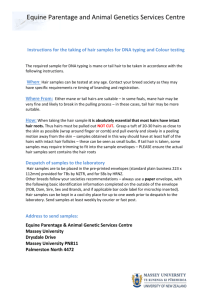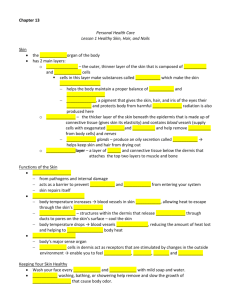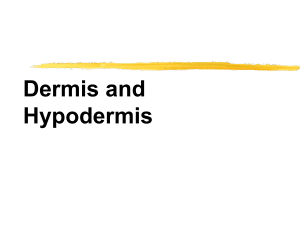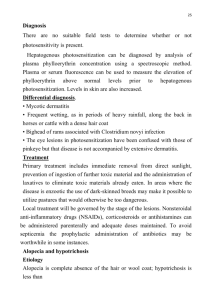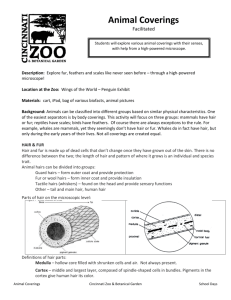Skin - Integumentary and Appendages Skin is the largest organ in
advertisement
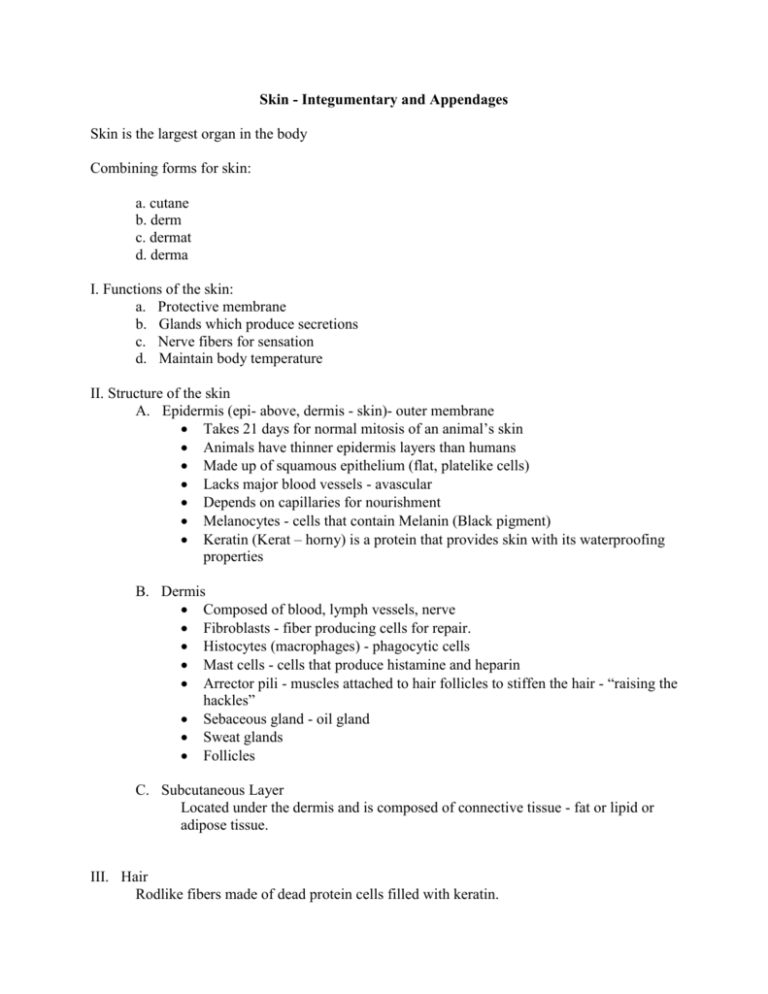
Skin - Integumentary and Appendages Skin is the largest organ in the body Combining forms for skin: a. cutane b. derm c. dermat d. derma I. Functions of the skin: a. Protective membrane b. Glands which produce secretions c. Nerve fibers for sensation d. Maintain body temperature II. Structure of the skin A. Epidermis (epi- above, dermis - skin)- outer membrane Takes 21 days for normal mitosis of an animal’s skin Animals have thinner epidermis layers than humans Made up of squamous epithelium (flat, platelike cells) Lacks major blood vessels - avascular Depends on capillaries for nourishment Melanocytes - cells that contain Melanin (Black pigment) Keratin (Kerat – horny) is a protein that provides skin with its waterproofing properties B. Dermis Composed of blood, lymph vessels, nerve Fibroblasts - fiber producing cells for repair. Histocytes (macrophages) - phagocytic cells Mast cells - cells that produce histamine and heparin Arrector pili - muscles attached to hair follicles to stiffen the hair - “raising the hackles” Sebaceous gland - oil gland Sweat glands Follicles C. Subcutaneous Layer Located under the dermis and is composed of connective tissue - fat or lipid or adipose tissue. III. Hair Rodlike fibers made of dead protein cells filled with keratin. A. Types of hair 1. Fur - short, fine, soft hair 2. Guard hairs - long, straight, stiff hairs that form the outer coat; primary hair or top coat. 3. Secondary Hairs - finer, softer, and wavy hair; undercoat. 4. Tactile Hair - long, brittle, extremely sensitive hairs usually located on the face B. Hair development 1. Simple - guard hairs that grow from separate follicular openings, as in cattle 2. Compound - multiple guard hairs that grow from a single follicle, as in dogs. C. Color of hair 3 primary pigments - black, brown, yellow Gray hair - loss of pigment White hair - absence of pigment and presence of air in the hair shaft D. Shedding/Molting Controlled by temperature, hormones, photoperiod, and nutrition IV. Nails, Horns, Hooves Quick - blood supply for nails/claws Coronary band (Coronet) - growth of the hoof Chestnuts/Ergots - vestigal pads in horses. Chestnuts are located on the medial surface of the leg above the knee or hock. Chestnuts correspond to carpal pads in the dog. Ergots are located in the tuft of hair on the fetlock joint. Ergots correspond to metacarpal and metarsal pads in the dog. Horn - permanent structure that grows continuously after birth. Breeds that are naturally hornless are called polled. Antler - not permanent and are shed and regrown annually. Antlers are initially covered with skin called velvet. When the animal rubs off the velvet, the bone is exposed, the antlers lose their blood supply and are shed off. V. Feathers A. Types of feathers 1. Contour - covers a bird’s body and constitutes the flight feathers a. Remigies - wing flight feathers b. Rectricies - tail flight feathers 2. Semiplume - found under contour feathers; provides insulation; help with buoyancy in water birds. 3. Down - soft feathers located near the skin to provide insulation 4. Filoplume - located on the neck and head 5. Bristles - around the eyes, nares, mouth; provides a sensory response B. Wing trims Larger birds - trim the first 4 primary remigies Smaller birds - trim the first 5-6 primary remigies V. Pathology 1. Abrasion - injury to superficial skin layers 2. Abscess - collection of pus 3. Acne - plugged sebaceous glands. Cats are prone to feline acne. Scrub the area with iodine and treat with benzoyl peroxide. 4. Hot spots (Pyoderma) - occurs due to intense scratching or licking due to allergy or inflammation 5. Alopecia - hair loss 6. Cellulitis - inflammation of connective tissue 7. Contusion - injury that does not break the skin; redness and inflammation 8. Dermatitis - inflammation of the skin 9. Discoid lupus erythematosus (Collie nose or solar dermatitis) -canine autoimmune disease. The bridge of the nose exhibits depigmentation, erythema, scaling and erosions. Commonly seen in Collies, German Shepherds, Huskies, Labs, and Sheep dogs. 10. Ecchymosis (bruise) - bleeding into the skin from a broken blood vessel. 12. Eczema - general term for inflammatory skin disease; crusts, scabs, vesicles, papules 13. Fissure - cracklike sore 14. Fistula - abnormal passage from an internal organ to the body surface Perianal fistula 15. Gangrene - necrotic tissue. 16. Granuloma (Proud Flesh) - scar tissue 17. Lipoma - fatty tumor 18. Melanoma - tumor of the pigment cell . 19. Papule - small, raised skin lesion 20. Pemhigus - immune mediated skin disease; ulcers, blisters; most common in Akitas, Chows, Dobies, German Shepherds, Labs, Newfies 21. Petechie - small, pinpoint hemorrhages. 22. Sebaceous cyst - closed sac of yellow fatty material. 23. Ulcer - open sore Decubital ulcer - (bed sore) erosions of skin as a result of prolonged pressure 24. Urticaria - hives 25. Vesicle - blister; fluid filled sac 26. Erythema - redness of the skin indicating inflammation 27. Pruritus - itching 28. Schnauzer Comedo Syndrome Hereditary disorder of follicular Keratinization Small crust on the back Treatment - benzoyl peroxide shampoo 29. Demodectic Mange - “cigar shape mite” Mites live within the hair follicle Signs: patches of alopecia, variable erythema, secondary bacterial infection; head and limbs are affected Treatment - Benzoyl peroxide shampoo Zoonotic 30. Sarcoptic Mange - burrowing mite Mite has a short life in the environment Signs: itching, crusted area around the ears, elbows, hocks, inguinal area Treatment: Mitaban, Dips Not zoonotic 31. Cheyletiella - Walking Dandruff Affects dogs, cats and rabbits. Mites feed on the skin scales and can live up to 10 days in the environment. Signs: pruritic skin Dx: scotch tape, skin scraping Tx: ivermectin 33. Cuterebriasis - most common in rabbits Botfly lays the eggs in the soil or feces, the larvae hatch and penetrate the skin, mature to the pupal stage beneath the skin. There will be a small air hole in the skin for the pupal to breath. To remove the pupal, carefully extract it without crushing it or the rabbit will die from the toxin being released. 34. Dermatophytosis - Ringworm Zoonotic fungus commonly seen in cats Signs: alopecia, scaling, inflamed rash or lump Dx: woods lamp, signs, DTM media Tx: Antifungal cream or shampoo 35. Lick granuloma Causes are usually boredom or irritation to the area. Signs: the animal will lick the area constantly causing alopecia, inflammation, open sores. 36. Warts



